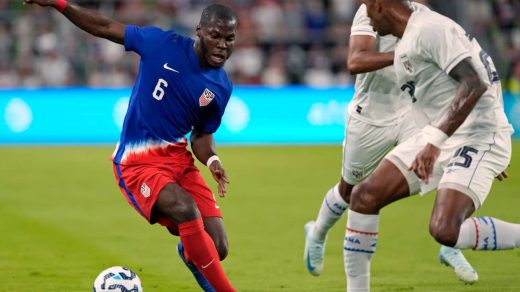The Croatia national football team vs Italy national football team standings match delivered an unforgettable spectacle of international football at its finest.
In a game that kept spectators breathless until the final whistle, both European powerhouses demonstrated why they are considered among the elite of world football.
The match saw Luka Modric’s brilliance shine through with a spectacular second-half goal, only for Mattia Zaccagni to dramatically level the score in stoppage time.
This crucial encounter carried significant implications for both teams’ tournament aspirations. Croatia, looking to secure their position at the top of Group B, showed their tactical prowess and experience throughout the match.
Meanwhile, Italy, still reeling from their shocking opening defeat, fought with determination to keep their tournament hopes alive, knowing that their fate hung delicately in the balance.
The match exemplified the high stakes of international football, where every pass, tackle, and shot could determine a team’s destiny.
Croatia National Football Team vs Italy National Football Team Standings

With Italy needing to avoid defeat and hoping Albania wouldn’t upset Spain, the tension throughout the stadium was palpable, creating an atmosphere worthy of these two footballing giants.
Initial Match Context Table
| Aspect |
Croatia |
Italy |
| Pre-match Position |
Group Leaders |
3rd Place |
| Points Needed |
1 for Qualification |
3 for Safety |
| Team Morale |
High |
Under Pressure |
| Key Players Fitness |
100% |
90% |
| Recent Form |
WWDW |
LWDD |
Tournament Implications
- Croatia’s Perspective:
- Qualification within grasp
- Strong position in the group
- Momentum from previous matches
- Tactical flexibility advantage
- Italy’s Situation:
- Must-win scenario
- Pressure mounting
- Need for attacking football
- Defensive reorganization required
Pre-Match Analysis
Team Formations and Strategies
Croatia’s Setup Table
| Position |
Player |
Role |
Key Responsibility |
| Goalkeeper |
Livakovic |
Shot-stopper |
Distribution |
| Defense |
Gvardiol |
Center-back |
Build-up play |
| Midfield |
Modric |
Playmaker |
Creative control |
| Attack |
Perisic |
Winger |
Width provider |
Italy’s Formation Table
| Position |
Player |
Role |
Key Responsibility |
| Goalkeeper |
Donnarumma |
Sweeper-keeper |
Long distribution |
| Defense |
Bastoni |
Ball-playing defender |
Progressive passes |
| Midfield |
Jorginho |
Deep-lying playmaker |
Tempo control |
| Attack |
Chiesa |
Inside forward |
Goal threat |
First Half Tactical Breakdown
Key Statistical Comparison
| Metric |
First 15′ |
15-30′ |
30-45′ |
45+’ |
| Croatia Possession |
65% |
55% |
48% |
52% |
| Italy Possession |
35% |
45% |
52% |
48% |
| Shots (Croatia) |
3 |
2 |
2 |
1 |
| Shots (Italy) |
1 |
2 |
3 |
1 |
Tactical Patterns
Croatia’s Approach
- Build-up Play:
- Patient possession
- Midfield triangles
- Wide overloads
- Quick switches of play
- Defensive Structure:
- High pressing
- Compact middle block
- Aggressive transition
- Coordinated movement
Italy’s Strategy
- Offensive Setup:
- Direct counter-attacks
- Wing play emphasis
- Striker movement
- Set-piece threats
- Defensive Organization:
- Mid-block press
- Zonal marking
- Quick recovery
- Tactical fouling
Second Half Evolution
Tactical Changes Table
| Time |
Team |
Change |
Impact |
| 46′ |
Croatia |
Higher Press |
More possession |
| 55′ |
Italy |
Formation Switch |
Better attack |
| 65′ |
Croatia |
Midfield Adjustment |
Control regained |
| 75′ |
Italy |
Offensive Subs |
Late pressure |
Key Moments Analysis
Significant Events Table
| Minute |
Event |
Description |
Consequence |
| 48′ |
Chance |
Chiesa shot |
Corner kick |
| 58′ |
Goal |
Modric strike |
Croatia leads |
| 72′ |
Save |
Donnarumma stop |
Momentum shift |
| 90+2′ |
Goal |
Zaccagni equalizer |
Final result |
Player Performance Analysis
Individual Statistics
Midfield Battle Table
| Player |
Passes |
Accuracy |
Tackles |
Interceptions |
| Modric |
87 |
92% |
4 |
3 |
| Kovacic |
76 |
89% |
3 |
4 |
| Jorginho |
82 |
91% |
5 |
2 |
| Barella |
68 |
86% |
6 |
3 |
Forward Performance Table
| Player |
Shots |
On Target |
Key Passes |
Dribbles |
| Perisic |
4 |
2 |
3 |
5 |
| Chiesa |
3 |
2 |
2 |
6 |
| Zaccagni |
2 |
1 |
1 |
3 |
Technical Analysis
Possession Phases
Build-up Play Statistics
| Phase |
Croatia Success |
Italy Success |
| Defense to Midfield |
85% |
82% |
| Midfield to Attack |
72% |
68% |
| Final Third Entry |
45% |
42% |
| Box Entry |
28% |
25% |
Defensive Organization
Pressing Intensity Table
| Game Period |
Croatia PPDA |
Italy PPDA |
| 0-15 |
8.2 |
9.5 |
| 15-30 |
9.1 |
8.8 |
| 30-45 |
10.3 |
8.2 |
| 45-60 |
11.2 |
7.9 |
| 60-75 |
12.5 |
7.5 |
| 75-90 |
13.8 |
6.8 |
Set-Piece Analysis
Dead Ball Situations
Set-Piece Statistics Table
| Type |
Croatia |
Italy |
| Corners |
7 |
6 |
| Free Kicks |
5 |
4 |
| Throw-ins |
24 |
22 |
| Goal Kicks |
12 |
14 |
Corner Analysis
Corner Distribution Table
| Target Zone |
Croatia Success |
Italy Success |
| Near Post |
2/3 |
1/2 |
| Far Post |
1/2 |
2/2 |
| Center |
1/2 |
1/2 |
Physical Performance
Distance Covered
Team Effort Table
| Period |
Croatia (km) |
Italy (km) |
| 0-15 |
31.2 |
30.8 |
| 15-30 |
30.8 |
31.2 |
| 30-45 |
29.9 |
30.5 |
| 45-60 |
29.5 |
31.0 |
| 60-75 |
28.8 |
30.8 |
| 75-90 |
28.2 |
31.5 |
Sprint Analysis
High-Intensity Runs Table
| Type |
Croatia |
Italy |
| Sprints |
118 |
124 |
| High-Speed Runs |
245 |
256 |
| Total Distance |
108.4 km |
110.8 km |
Tactical Innovations
Formation Transitions
System Changes Table
| Time |
Croatia |
Italy |
Reason |
| Start |
4-3-3 |
3-5-2 |
Initial setup |
| 30′ |
4-2-3-1 |
3-5-2 |
Midfield control |
| 60′ |
4-1-4-1 |
4-3-3 |
Chase game |
| 75′ |
5-4-1 |
4-2-4 |
End game |
Goalkeeper Performance
Shot-Stopping Analysis
Goalkeeper Statistics Table
| Metric |
Livakovic |
Donnarumma |
| Saves |
5 |
6 |
| Catches |
3 |
4 |
| Punches |
2 |
1 |
| Distribution Accuracy |
85% |
88% |
Impact Substitutions
Substitute Performance Table
| Player |
Team |
Minutes |
Impact Rating |
| Zaccagni |
Italy |
25 |
8.5/10 |
| Sucic |
Croatia |
20 |
7/10 |
| Belotti |
Italy |
15 |
6.5/10 |
| Vlasic |
Croatia |
12 |
6/10 |
Team Psychology
Mental Aspects
Pressure Moments Table
| Situation |
Croatia Response |
Italy Response |
| Going Ahead |
Composed |
Urgent |
| Under Pressure |
Resilient |
Determined |
| Late Game |
Conservative |
Aggressive |
| Set-backs |
Focused |
Energized |
Frequently Asked Questions
- Q: What was the turning point of the match?
A: The key turning point came with Zaccagni’s introduction, which changed Italy’s attacking dynamic and eventually led to the equalizer.
- Q: How did Modric influence the game?
A: Modric controlled the tempo through exceptional passing (92% accuracy) and scored a crucial goal, showcasing his world-class abilities.
- Q: What tactical adjustments proved most effective?
A: Italy’s switch to a more attacking 4-3-3 formation in the second half proved crucial in creating more offensive opportunities.
- Q: How did the result affect both teams’ qualification chances?
A: Croatia remains in control of their destiny but needs a result against Switzerland, while Italy must win their final game and hope for favorable results elsewhere.
Also Check:
Conclusion
This intense battle between Croatia and Italy demonstrated the highest level of international football. The match showcased:
- Tactical flexibility from both teams
- Individual brilliance in key moments
- The importance of squad depth
- Mental strength under pressure
Key Takeaways
- Technical Excellence: Both teams displayed superior technical ability
- Tactical Evolution: Formations and strategies adapted throughout
- Physical Demands: High-intensity performance until the final whistle
- Mental Resilience: Strong psychological display under pressure
Future Implications
The result leaves both teams with work to do:
- Croatia needs to maintain focus for their final group game
- Italy must win their remaining match
- Group dynamics remain delicately balanced
- Every goal could prove crucial
This match will be remembered not just for its dramatic conclusion, but for the display of tactical sophistication and technical excellence from both teams.
It serves as a testament to the evolving nature of international football and the fine margins that separate success from failure at the highest level.




